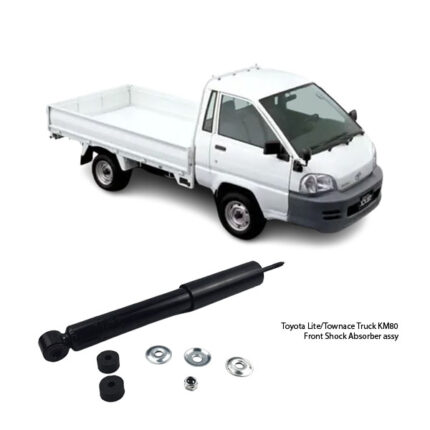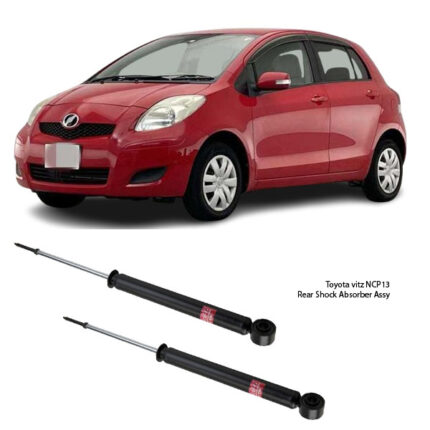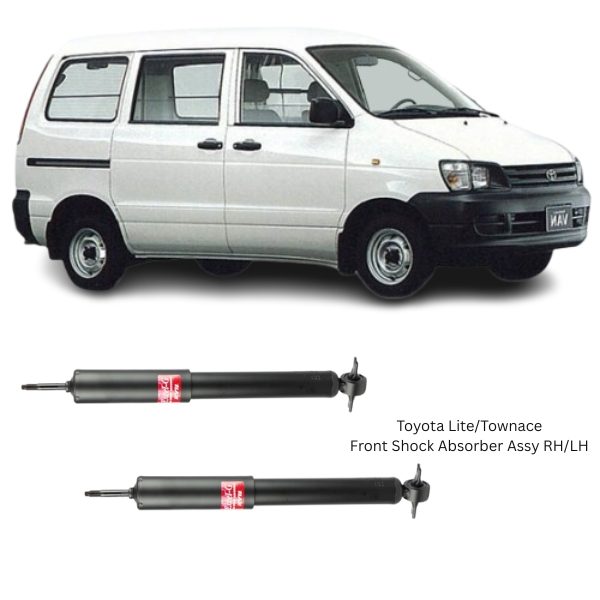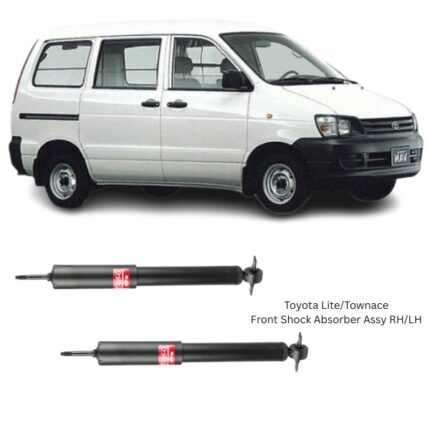Get Toyota Lite/Townace Front Shock Absorber Assy 343357 in Kenya
The Front Shock Absorber Assembly is one of the most essential components in a vehicle’s suspension system, designed to absorb and dampen shock impulses generated by road irregularities. Positioned between the vehicle chassis and the front wheels, this assembly ensures a smooth, stable, and controlled ride by moderating the movement of the suspension springs and minimizing excessive bouncing or body roll during driving, braking, or cornering.
Whether driving on a paved highway or rough terrain, the shock absorber’s role is to keep the tires in firm contact with the road surface while providing comfort and safety to the occupants. This is achieved by converting kinetic energy from suspension travel into thermal energy, which is then dissipated through hydraulic fluid or gas chambers inside the assembly.
Function and Purpose
The primary function of the front shock absorber assembly is to dampen the oscillations of the front suspension system. Without shock absorbers, a vehicle would bounce uncontrollably after every bump, compromising handling, safety, and comfort.
Key purposes include:
-
Controlling Spring Motion: Suspension springs absorb impact, but without shock absorbers, they would continue to oscillate. The shock absorber slows down and reduces this motion.
-
Enhancing Tire Contact: It helps keep tires firmly on the ground, improving traction and steering responsiveness.
-
Improving Ride Quality: It reduces vibration and harshness experienced inside the cabin.
-
Enhancing Stability and Braking: By minimizing nose-diving during braking and body lean during turns, it provides predictable handling.
-
Protecting Suspension Components: It reduces wear and tear on other suspension parts like control arms, bushings, and struts.
Structural Composition
The front shock absorber assembly consists of various mechanical and hydraulic components housed within a sealed cylindrical body. Key components include:
1. Piston and Piston Rod
-
The piston is connected to a rod that moves up and down inside the cylinder.
-
As the vehicle travels over uneven surfaces, the piston is forced through hydraulic fluid or gas, which resists motion and provides damping.
2. Cylinder (Tube)
-
Houses the hydraulic fluid and piston mechanism.
-
May be twin-tube (outer and inner tubes) or monotube (single high-pressure cylinder).
3. Hydraulic Oil
-
Specialized damping fluid used to slow piston movement and absorb kinetic energy.
-
Transfers energy as heat and maintains consistent damping under varying conditions.
4. Valving System
-
Consists of orifices and valves that regulate the flow of fluid during compression and rebound.
-
Determines the damping force based on vehicle speed and load.
5. Mounting Eyelets or Bushings
-
Connect the shock absorber to the chassis and control arms.
-
Often made of rubber or urethane to absorb minor vibrations and prevent metal-on-metal contact.
6. Dust Boot and Bump Stop
-
The dust boot shields the piston rod from dirt, water, and debris.
-
The bump stop cushions the shock when the suspension compresses fully, protecting the internal components from damage.
Damping Characteristics
Shock absorbers operate in two distinct phases:
Compression Stroke
When the vehicle wheel moves upward due to a bump, the shock absorber compresses. Hydraulic fluid is forced through the valve system from one chamber to another, generating resistance that slows down the suspension’s upward movement.
Rebound Stroke
As the spring pushes the wheel back down, the piston retracts, and fluid returns in the opposite direction. Damping is also applied during rebound, ensuring controlled extension without jerky motion.
Shock absorbers are tuned to provide greater resistance during rebound than compression to ensure maximum tire contact and stability.
Types of Shock Absorber Assemblies
There are two primary designs found in front applications:
1. Twin-Tube Shock Absorbers
-
Consist of an inner working tube and an outer reservoir tube.
-
More cost-effective and suitable for standard driving conditions.
2. Monotube Shock Absorbers
-
Contain a single tube with a floating piston separating gas and hydraulic fluid.
-
Offer better heat dissipation and consistent damping, ideal for performance or heavy-duty use.
Some shock absorbers may also feature gas-charging (typically nitrogen) to reduce cavitation, a condition where air bubbles form in the fluid under heavy usage.
Importance of the Front Shock Absorber
The front shock absorbers bear significant responsibilities due to their location:
-
Handle Steering Input Loads: Since they work alongside the steering system, they affect turning precision and feedback.
-
Manage Forward Weight Transfer: During braking, the front end dives, and shock absorbers help manage the impact.
-
Support Suspension Geometry: Work with other components like control arms and strut mounts to maintain proper alignment.
Because of these roles, any degradation in front shock performance can directly impact safety, tire longevity, and handling.
Symptoms of Worn Front Shock Absorbers
Timely inspection and replacement are critical. Common signs of failure include:
-
Bouncing or Excessive Movement: Vehicle bounces repeatedly after hitting bumps.
-
Poor Braking Performance: Increased stopping distance or nose-diving during braking.
-
Uneven Tire Wear: Especially cupping or scalloping patterns.
-
Fluid Leaks: Oil seepage on the shock body indicates internal seal failure.
-
Clunking Noises: Worn bushings or loose mounts.
-
Reduced Steering Precision: Especially noticeable on curves or under load.
Installation and Maintenance
Replacing a front shock absorber assembly is typically a mechanical task requiring precision and safety awareness. Installation steps include:
-
Lift the Vehicle: Safely raise and support using jack stands.
-
Remove the Wheel: Gain access to the suspension assembly.
-
Disconnect Mounting Bolts: Typically two bolts at the bottom and one or more at the top.
-
Extract the Old Shock Absorber: Carefully compress and remove.
-
Install New Shock: Position and tighten bolts to torque specifications.
-
Reassemble and Test Drive: Ensure smooth suspension travel and no abnormal noises.
A wheel alignment is recommended after replacing front shock assemblies, especially if they are part of a strut setup.
Routine inspection should be done every 20,000 to 30,000 kilometers, or as specified in maintenance schedules, depending on driving conditions.
Follow us on Facebook for more parts.




